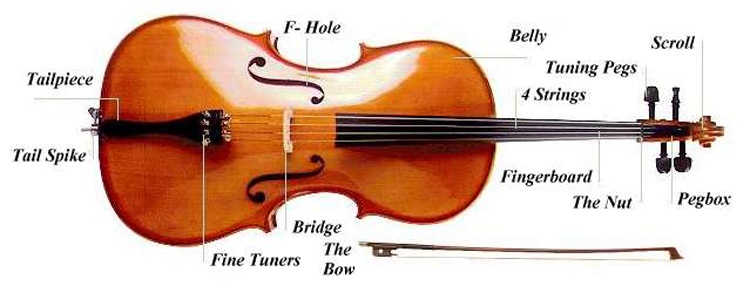cello

The cello, or to give it its full name violoncello, is a large, baritone instrument of the violin family, which superceded the viol da gamba in the early part of the eighteenth century. The cello is held by the performer between his or her knees and played with a bow. It has four strings made of gut, metal, or synthetic materials, such as Perlon. Most modern strings used today are also wound with metallic materials such as aluminum, titanium, and chromium. Cellists may mix different types of strings on their instruments. They are tuned in perfect fifths, the first or upper string sounding A on the fifth line of the bass clef, and the others the D, G, and C successively below. It has an enormous range: from the open C string up to c''' and even higher in the hands of some soloists. Its key signature is usually the bass clef, the tenor or treble clef being used for the higher notes.
The cello has an amazingly expressive and flexible tone, closer to the human voice than any other non-electronic instrument. Consequently it has been a very popular instrument among composers from its inception to the present day. In classical music, the concertos of Edward Elgar and Antonin Dvorák are the best known. In contemporary popular music, cellos have been used by, among others the Beatles (e.g. Eleanor Rigby), Aerosmith, Goo Goo Dolls, Paul Weller (A Year Late), and Damien Rice. In a subgenre of rock, called cello rock, cellists feature prominently. Examples of cello rock bands are Apolcalyptica, Rasputina, and Coppelius.
History of the cello
The original bass violins had three strings tuned to F-c-g; a fourth string was added in the mid-1500s giving a low B♭. The bass violin was often known as the violone and was at least 80 centimeters (31 inches) long in order to accommodate the long gut strings. The development of overspinning meant the strings could be shortened by about 1 per cent, making the instrument much more manageable. This new size was the cello.
Cremona, Italy, was the center for making bass violins, and it was Stradivari, as in the case of the violin, whose work established the cello's size and basic construction. His work in the early eighteenth-century set the cello's body size at 75–76 centimetersm (30 inches), which was ideal for a tuning system of C-G-d-a that by then had become standard.


